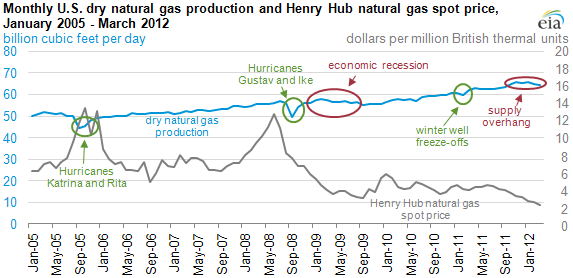
U.S. dry natural gas production growth levels off following decline in natural gas prices

U.S. dry natural gas production has increased since late 2005 due mainly to rapid growth in production from shale gas resources. However, there have been two notable instances (see red ovals in the chart) in the last seven years when natural gas production leveled off during a period of falling spot natural gas prices. The first was during the recent economic recession and the latest began in the fourth quarter of 2011 and continued through the first quarter of 2012.
Weather events (see green ovals) have also affected U.S. natural gas production.
The major events over the past seven years that have caused dry gas output to level off or even decline include:
- Hurricanes Katrina and Rita (Sep-Oct 2005) - Disrupted up to 12.2 billion cubic feet per day (Bcf/d) in offshore natural gas production.
- Hurricanes Gustav and Ike (Sep 2008) - Disrupted up to 9.5 Bcf/d in offshore natural gas production.
- Economic recession and falling prices (Oct 2008- Sep 2009) - Reduced industrial and manufacturing activity, and lower electricity use eased demand for natural gas as a feedstock and a power generation fuel. Natural gas prices fell sharply as a result.
- Winter well freeze-offs (Feb 2011) - Disrupted up to 7.5 Bcf/d in natural gas production from Texas to Arizona, when water froze inside wellheads during extremely cold weather and blocked gas flows.
- Supply overhang and falling natural gas prices (Oct 2011-Mar 2012) - A warm winter that reduced heating fuel demand and record high gas inventories resulted in a nearly 50% drop in gas prices, causing some energy companies to postpone new drilling and cut back on some existing operations.
Natural gas production was relatively flat between October 2011 and March 2012, when Henry Hub spot gas prices declined from just above $3.50 to around $2.00 per million British thermal units in March. Preliminary EIA data indicate a slight drop in production during March, according to the Natural Gas Monthly report released on May 31.
Of the five large gas-producing states tracked monthly by EIA—Texas, Louisiana, New Mexico, Oklahoma, and Wyoming—New Mexico had the highest percentage decline in its March gross natural gas production, down 2.2 percent from the previous month, while Texas had the largest volumetric drop, down 150 million cubic feet per day. States that EIA does not presently track on a monthly basis, such as Pennsylvania, may have seen their gas output increase during March.
Tags: Louisiana, natural gas, Oklahoma, prices, spot prices, states, Texas, weather, Wyoming